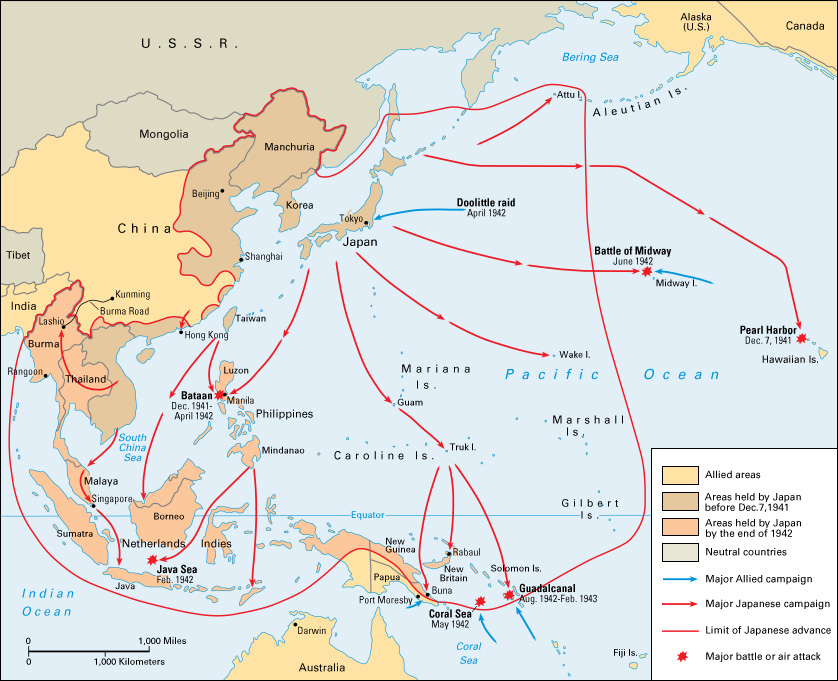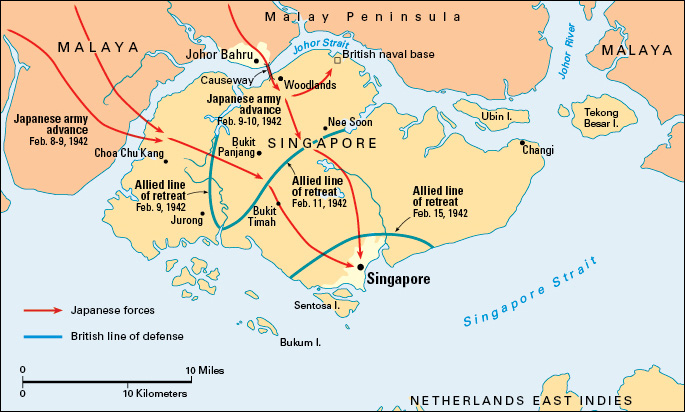Singapore, Battle of, was a clash of Japanese forces against British and Commonwealth forces during World War II (1939-1945). The battle took place in February 1942 and ended in a decisive Japanese victory. Singapore consists of one large island and numerous smaller islands off the tip of the Malay Peninsula in Southeast Asia. The conquest of Singapore cleared the way for Japan’s further expansion in the region. The battle’s end saw the largest ever surrender of British-led troops.
Background.
Singapore had been a British colony since 1867. During the 1930’s, Japan was aggressively expanding its control in the Pacific. In response, the British fortified Singapore. They built airfields and strengthened their naval base. They placed heavy guns around the base and the port city of Singapore. All the guns faced the sea, because the British believed the jungle north of the city was too dense for a land invasion. The guns could be turned to face inland, but their ammunition was designed for naval targets. The British considered Singapore an impregnable (unconquerable) fortress.

On Dec. 7, 1941, Japan attacked the United States naval base at Pearl Harbor, Hawaii. The United Kingdom declared war on Japan on December 8. That same day, Japanese troops landed in southern Thailand and northern Malaya (now part of Malaysia). Malaya also was a British colony at that time. Malaya and the Dutch East Indies (present-day Indonesia) contained valuable petroleum, rubber, and tin that Japan needed for its war effort.
Japanese troops routed the British and Commonwealth troops in Malaya. Thousands of Allied troops were killed, wounded, or taken prisoner. Surviving Allied troops completed their withdrawal to Singapore on Jan. 31, 1942. The troops partially destroyed the causeway (raised roadway) linking Malaya to Singapore, delaying the Japanese advance.
The battle.
On February 8, thousands of Japanese troops crossed the narrow Johor Strait between Malaya and Singapore. They landed in the mangrove swamps and jungles of Singapore’s lightly defended northwest shore. Over the next two days, thousands more Japanese landed nearby. Caught by surprise, the Australian, British, Indian, and Malayan defenders fell back in disarray.

The Japanese had fewer troops than the defending Allies, but they had a great advantage in mobility, tanks, and warplanes. The Japanese soon closed on the city of Singapore. They trapped the Allied soldiers along with some 1 million civilians.
Japan’s General Tomoyuki Yamashita demanded that the Allies surrender. Casualties (people killed or wounded) were mounting, and the Allies were low on ammunition, food, and other supplies. On February 15, British Lieutenant General Arthur Percival surrendered more than 60,000 troops to the Japanese.
Aftermath.
The Japanese suffered about 5,000 casualties in the Battle of Singapore. Some 60,000 Australian, British, Indian, and Malayan troops became prisoners of war. Over the next few years, thousands of these troops died in brutal prison camps. The battle and Japanese occupation also claimed the lives of thousands of civilians. The fall of Singapore was a catastrophe for the United Kingdom. British Prime Minister Winston Churchill called it “the worst disaster and largest capitulation in British history.”
After the Battle of Singapore, Japanese forces destroyed a nearby Allied fleet and took the Dutch East Indies in March 1942. The Japanese advance finally was stopped at the Battle of the Coral Sea, northeast of Australia, in May. The Japanese occupation of Singapore ended shortly after Japan’s official surrender on Sept. 2, 1945.
